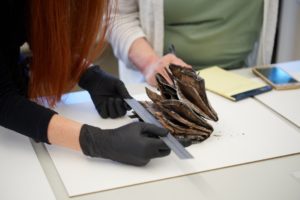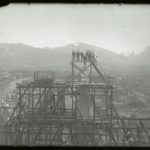128 year old Salt Lake Temple time capsule opened
Jul 29, 2020, 11:23 AM
SALT LAKE CITY — 128 years ago on April 6, 1892, President Wilford Woodruff, the fourth president of The Church of Jesus Christ of Latter-day Saints laid the capstone of the Salt Lake Temple by pressing a button that activated an electric motor to lower the capstone and the 12-foot 5-inch statue of the angel Moroni into place atop the temple’s eastern spire.
 Laying that spherical stone signified the end of 39 years of construction. The building would be dedicated a year later. Inside were placed four packages wrapped in silk oilcloth: one in the north, south, east and west parts of the capstone.
Laying that spherical stone signified the end of 39 years of construction. The building would be dedicated a year later. Inside were placed four packages wrapped in silk oilcloth: one in the north, south, east and west parts of the capstone.
The packages were part of a time capsule and a common form of celebration during construction projects, Emily Utt, historic sites curator for the church said.
“This is a moment to reflect on the last 39 years of construction and to give the people the last little bit of motivation to get this building done.”
But, “Time capsules really aren’t meant to be long-term archival storage,” she said.
The Salt Lake Temple capstone time capsule
Elder James E. Talmage wrote in 1912 that a number of books and photographs as well as a copper engraving of the history of the building were included in the Salt Lake Temple time capsule. Elder Talmage also noted there were photographs of Joseph Smith and his brother Hyrum, something current church historian Elder Legrand R. Curtis said are an important discovery.
“There are no known photographs of Joseph Smith,” he said. “If there really was a photograph of Joseph Smith that would be a find.”

Crews watch after the Angel Moroni statue is removed from atop the Salt Lake Temple of The Church of Jesus Christ of Latter-day Saints during renovation in Salt Lake City on Monday, May 18, 2020. Jeffrey D. Allred, Deseret News
This past March the angel Moroni, along with the 3,800 pound stone he had stood atop since 1892 was damaged during the 5.7 M earthquake that rocked northern Utah in March. There were plans in place for the removal of the statue and capstone as part of ongoing renovations for the temple, but the plan was moved forward after the earthquake.
“The capstone was created in two halves and then mortared together at the seam around the circumference,” Twitchell said. “Our hope was that we could cut around that mortared seam and just pop the two parts of the ball apart, and then uncover the time capsule that we knew was inside.”
But it was more difficult than that. The capstone had been filled with concrete.
“Our opening [of the capstone] has been a few people on a loading dock with very small chisels. I don’t know if [the people of 1892] could have imagined that kind of interaction,” Utt said. “They had such fanfare. Our opening has been much quieter.”
After chiseling through the concrete-filled stone church historians were able to find out what remained inside.
What’s inside?

Emiline Twitchell, conservator at the Church History Library, removes items from the Salt Lake Temple capstone time capsule in Salt Lake City on Wednesday May 20, 2020. Jeffrey D. Allred, Deseret News
According to the Church, the contents found inside as of mid-July are:
South packet (located in the top half of capstone):
- “Voice of Warning” by Parley P. Pratt
- “Key to the Science of Technology” by Parley P. Pratt
- Book of Mormon
- Pearl of Great Price
- “The Martyrs: A Sketch of the Lives and a Full Account of the Martyrdom of Joseph and Hyrum Smith” by Lyman O. Littlefield
- Unidentified book
- Unidentified paper
East packet (also in the top half of capstone):
- The Holy Bible
- Spencer’s Letters (Orson Spencer’s correspondence with the Reverend William Crowell explaining the Church’s doctrine)
- 3 unidentified books
North packet (located in the bottom half of capstone): Gold-leafed copper plate inscribed with “Holiness to the Lord,” notable dates in Salt Lake Temple construction, and the names of general authorities at time of the groundbreaking in 1853 and as constituted on April 6, 1892
 West packet (also in the bottom half of capstone): Paper envelope containing approximately seven unidentified mounted photographs known as cabinet cards.
West packet (also in the bottom half of capstone): Paper envelope containing approximately seven unidentified mounted photographs known as cabinet cards.
The concrete that had filled the capstone led to the deterioration of a lot of the paper materials found inside.
“Concrete will sweat and leach and get hot as it’s curing,” Twitchell said. “And the books essentially were sponges to all of this process that the cement is doing. And so they just leached in all of that moisture and sat for decades and decades and decades.”
Two days after the capstone’s removal, the First Presidency of the church were invited to see what was found.
“We did not expect to find much because we knew that the contents of the capstone had not been insulated from the weather during the 128 years that had elapsed,” said President Nelson.
“But we wanted to be there anyway, just to be close and to pay tribute to the leaders and courageous pioneer craftsmen who against all odds built this magnificent temple.”
What’s next?
 At this point, the materials found in the capstone will be conserved in their current state and cataloged into the Church History Department’s collections that are available to other researchers and scholars, Utt said.
At this point, the materials found in the capstone will be conserved in their current state and cataloged into the Church History Department’s collections that are available to other researchers and scholars, Utt said.
After that, the plan is to display the items to the public.
“We’re hopeful that we can put them on exhibit so people can see them. We still don’t know what we have. So really the next step is research.”






































